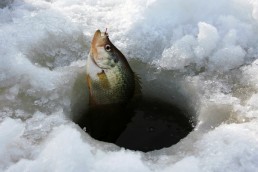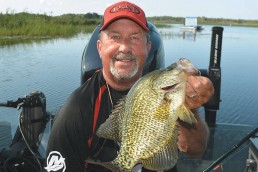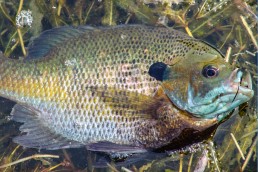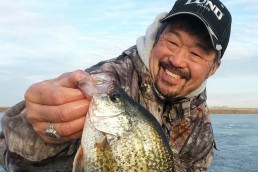Catch Ice Bull Bluegills and Slab Crappies
SHARE THIS POST
Tricks and Tactics
As the ice season starts, you make your way to your starting spot on safe ice. Once at the target area, you drill a few holes and, with your portable sonar, check for signs of life in each. You see activity in one of the holes and set up your shelter, start up the heater and get settled. You drop your first bait down the hole and, on your flasher, see a fish come out of nowhere to meet it as it falls. Your line goes slack and you set the hook. Hopefully it’s a bull bluegill or a slab crappie. Let’s take a look at a few tactics that I turn to when looking for bulls and slabs during the ice season.
Location, location, location
Finding slab crappies and bull bluegills depends on the body of water, but, for sure, try to stay away from the crowds. I don’t get in the mix unless one of my good waypoints is there. Maybe it’s a weed change, or a hard-bottom spot. Increasing angler activity tends to push the fish towards the edges, away from the noise and the fishing pressure. To catch them, you must move with the fish.
The last few ice seasons, I’ve been successful by targeting depression or holes on the flats. A lake chip and a GPS help find these holes. A high definition LakeMaster Map chip in my Humminbird Helix Ice 7 shows how many such areas are on each lake and their locations.
Now, I can find these depressions on the lake and get to work. Getting to an area, I drill a few scouting holes and look for fish activity and pay attention to depth and weed conditions. For checking weed conditions, the easiest way is to get inside of the shack and look down the hole if the water is clear. When faced with deeper holes or cloudy water conditions, an underwater camera gives me a better look. I also look for weed changes— more about that later.
Move to where the fish are moving
If I see fish activity, I start fishing. As the action starts, I pay close attention to fish movements. Is the population of fish living in the area or were the fish just passing through? I can tell which areas hold fish and where they just pass through by how active the bite is. This is important. If the area holds fish, I can set up. But, if the fish are not residents, I must figure out precisely when they move through and be sure I am set up when that bite happens. It takes a few trips to the ice to figure out these answers.
Weed conditions dictate my presentation. If the weeds are still up and thick, I use a horizontal presentation as I can keep the horizontal bait up above the weeds to attract bites. If the weeds are pretty much gone, I will turn to a tungsten vertical presentation for bites. Try both options and tip both your baits with plastics, waxies or euros. Let the fish tell you which bait presentation they want and how they want it tipped.
One more point: don’t give up on both presentations. Many times one presentation catches most of the fish that day, but the other might get the bites from the bulls and slabs for which you are searching.
Are you enjoying this post?
You can be among the first to get the latest info on where to go, what to use and how to use it!
Weed changes: where the big bull bluegills and slab crappies hide
Throughout the year (not just in ice fishing), some of the biggest fish in the lakes are drawn to transition areas. These areas include the transition from hard to soft bottom or rocks to gravel. Any area of change can attract fish and, many times, some of the biggest fish in the lake. Weed changes also attract the bigger fish, especially during ice-fishing season. When you can find weed changes out on the flats or on the outside edges, you have an area that attracts food as well as the bulls and slabs. In clear water, just get into your shelter on a sunny day and look down into the water. If you see something, drill a few more holes in the area and fish. When you catch a few fish, drop a waypoint so you can return.
An underwater camera works great for discerning what weeds are present and where the two different weeds mix. You can also tell if fish are in the area before you drill more holes, which saves time.
Equipment
Consistently catching bull bluegills and slab crappies requires the right equipment. If your bait doesn’t look natural, you won’t get many bites. Here are the keys that I go by. Much of the time I use an older fiberglass rod because it has a lot of play in the tip action. I look at this as a natural spring bobber. The fiberglass rod also helps you in a few more ways. You know how you can feel the fish better on a new graphite rod? The fish can feel you just as well and often spit the baits out faster. Also, the bulls and slabs usually don’t want the bait overworked. We have all been there. We watch our electronics as the fish come up to the bait but shy away when you move the bait. A fiberglass rod can dampen some of this movement, triggering more bites. Line choice is critical: 1- and 2-pound-test line is the norm, and I recommend mono. Not fluorocarbon or braid. No 3- or 4-pound-test line. Your bait won’t look right or have a natural fall, which costs you bites.
One more point: Use a straight-line reel on your fiberglass rod. Your line won’t have any coil to it as it comes off of the spool, increasing sensitivity. With no coil in your line, you can feel the slightest of bites and that is key. Normal panfish don’t get to be bulls and slabs by being unwary. They have lived to be the biggest in the school, which means they are wary eaters.
Read up and ice ’em down
So, if you are looking to put the big bulls and slabs on the ice this year, try some of these suggestions. I do have to ask you a favor, though. When these tactics start to work, please put many of these bulls and slabs back down the hole. Keep some of the smaller fish, if you are looking for a meal. When these fish spawn, they will pass on what has made them the kings of the weed flats. Let that be passed on so your kids can catch the next generation of bulls and slabs in due time.
Looking for something with a bit more bite? Check out our article on ice-fishing for big pike!
MWO
SHARE THIS POST
Did you enjoy this post?
You can be among the first to get the latest info on where to go, what to use and how to use it!
Scott Petersen
Scott Petersen has been writing for the past 30 years. A Minnesota native, he has a passion to fish all seasons on ice and open water. “One of my main goals is to teach people how to fish through my articles and sport-show seminars.”



